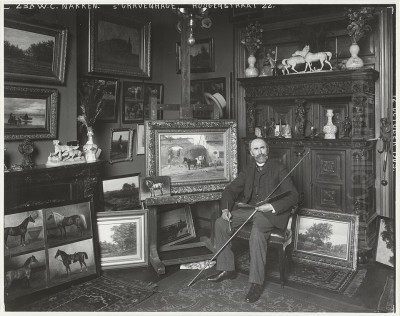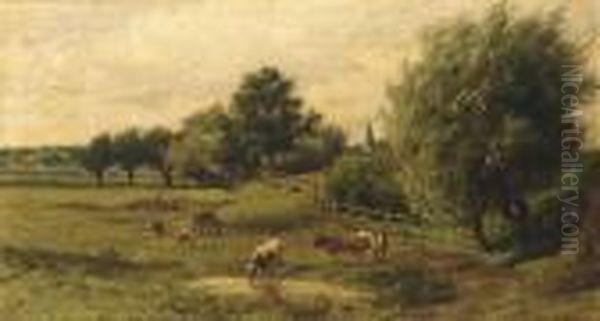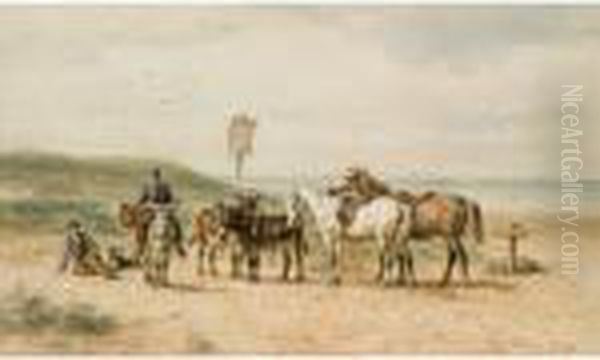
Willem Carel Nakken stands as a significant figure in Dutch art during the latter half of the 19th and the early 20th centuries. Born in the historic city of Delft in 1835, he later moved to Rijswijk, another town in the Netherlands, where he lived until his passing in 1926. Nakken carved a niche for himself primarily as a painter of landscapes and animals, demonstrating a particular affinity and skill for depicting horses within serene, rural settings.
His work is often characterized by a delicate and detailed approach, capturing the tranquil beauty and inherent naturalism of the Dutch countryside. Working predominantly in oil and watercolor, Nakken's paintings evoke a sense of peace and a deep appreciation for the rhythms of rural existence. He was not merely an observer but a sensitive interpreter of the world around him, translating the quiet dignity of farm life and the vitality of its animal inhabitants onto canvas and paper.
Early Influences and Artistic Formation
While details of his earliest training remain somewhat sparse, it is known that Nakken's formal artistic education took place at the prestigious Royal Academy of Art in The Hague. Sources suggest his period of study occurred around the 1870s, potentially spanning from the late 1860s into the early 1870s, or perhaps more concentrated between 1876 and 1880. During this formative time, he worked with Johannes van der Veld (1818-1904), an established painter associated with the Academy. Van der Veld's guidance likely played a role in shaping Nakken's technical skills and artistic direction.
Although not direct mentors in the same way as van der Veld, Nakken's artistic lineage can be traced back through historical family connections. He was related, albeit distantly through ancestry, to earlier Flemish artists like Willem van den Broeck, his son Chrispijn van den Broeck, and Chrispijn's father, Jan van den Broeck. While these 16th-century figures wouldn't have directly influenced his 19th-century style, this connection places Nakken within a long tradition of artistry originating from the Low Countries. His contemporary interactions within the Hague art scene, however, were more immediately impactful.
Artistic Style: Realism and the Dutch Landscape

Willem Carel Nakken's artistic output aligns broadly with the traditions of Dutch Realism and Naturalism prevalent during his time, echoing the legacy of the Dutch Golden Age while engaging with contemporary sensibilities. His work eschews overt romanticism or dramatic historical narratives, focusing instead on the faithful and meticulous depiction of the observable world, particularly the rural landscapes and animal life of the Netherlands.
His style is marked by a keen eye for detail. Whether painting the musculature of a horse, the texture of hay in a stable, or the play of light across a summer field, Nakken demonstrated considerable technical proficiency. He possessed a strong ability to capture atmospheric conditions and the subtle nuances of light and shadow, lending his scenes a convincing sense of place and time. The overall mood of his work is often one of tranquility and quiet observation.
Nakken was adept in both oil painting and watercolor. His oils often possess a richness and depth, while his watercolors showcase a lighter touch, capturing luminosity and immediacy. Regardless of the medium, his commitment to realistic representation remained paramount. He sought to portray the Dutch countryside and its inhabitants with honesty and affection, celebrating the unadorned beauty of everyday rural life.
The Horse: A Central Motif
While Nakken painted various aspects of rural life, including cattle and landscapes, he gained particular renown for his depictions of horses. Horses feature prominently throughout his oeuvre, appearing in diverse settings: pulling ploughs in fields, gathered at bustling market squares, resting in stables, or accompanying figures on beach excursions. His fascination with these animals is evident in the care and accuracy with which he rendered them.
Nakken demonstrated a profound understanding of equine anatomy and movement. His horses are not mere accessories in a landscape but are often the central subjects, portrayed with individual character and vitality. Works like Study of a Plough Horse reveal his dedication to capturing the form and essence of the working horse. Other paintings, such as those depicting horse markets or stables, explore the relationship between humans and horses within the context of agricultural life.
His ability to portray horses convincingly contributed significantly to his reputation. In an era when horses were still integral to transportation, agriculture, and daily life, Nakken's sensitive and skilled representations resonated with audiences and fellow artists alike, solidifying his status as a master of equine art within the Dutch tradition.
Notable Works and Themes

Willem Carel Nakken's body of work includes numerous paintings that exemplify his characteristic style and thematic interests. Among his representative pieces are:
Market with Horses: An oil painting (75 x 100 cm) likely depicting a lively scene of commerce and equine activity, showcasing his skill in handling complex compositions with multiple figures and animals.
Cows in a Summer Landscape: This work, noted as a representative piece, highlights his ability to capture the peaceful atmosphere of the Dutch countryside, focusing on cattle within a natural setting, likely emphasizing light and pastoral tranquility.
Shepherd on the Road through the Forest: A landscape (41.5 x 81.5 cm) suggesting a more solitary, perhaps slightly more romanticized view of rural life, focusing on the interplay of nature and a lone figure.
Preparing to Ride a Donkey: Available in both oil/canvas (38.1 x 51.6 cm) and watercolor versions, this theme suggests scenes of leisure or preparation for travel, often featuring coastal settings.
Horses and Donkeys on the Beach: This title points towards Nakken's interest in coastal scenes, combining his skill in animal depiction with the specific light and atmosphere of the seaside.
Study of a Plough Horse: A small watercolor (8.9 x 13.3 cm) demonstrating his focus on the working animal, likely a detailed anatomical or character study.
Boer bij paarden in de stal (Farmer with horses in the stable): An interior scene (34 x 51 cm) focusing on the intimate relationship between farmer and animal within the stable environment, allowing for studies of light within an enclosed space.
A Turbaned Donkey: Exhibited and listed in official catalogues, this title suggests an element of the exotic or perhaps a study from travels, though Nakken is primarily known for Dutch scenes.
Bauer mit seinen Pferden an der Tränke (Farmer with his horses at the trough): Another variation on the theme of farmers and their working horses, emphasizing daily routines.
These works, varying in medium, size, and specific subject, collectively illustrate Nakken's dedication to depicting the animals, landscapes, and human activities that defined rural Dutch life in his time.
Nakken as Collector and Patron
Beyond his own artistic practice, Willem Carel Nakken played an active role in the art community of his time, notably as an art collector and a supporter of fellow artists. He demonstrated a keen interest in the work of younger painters emerging from The Hague art scene. His collection included pieces by artists such as Jan van Bommel, Floris Arntzenius, Hendrikus Matheus Horrix, and Johannes Evert Hendens. This activity highlights his engagement with contemporary trends and his desire to support the next generation.
One particularly notable anecdote underscores his generosity and commitment to his peers. In 1880, his friend and fellow painter, Willem de Zwart (initially misidentified in some accounts as Pieter Zwart), was conscripted into military service. Serving in the army could significantly disrupt an artist's burgeoning career. Nakken took it upon himself to help his friend. By selling some of his own paintings, likely works from his earlier period, Nakken raised the necessary funds to purchase a military exemption for de Zwart, allowing him to continue his artistic pursuits uninterrupted. This act speaks volumes about Nakken's character and his supportive role within the artistic fraternity.
Connections, Collaborations, and the Hague Art Scene
Willem Carel Nakken was well-integrated into the artistic circles of The Hague. His association with the Royal Academy of Art provided a foundation, and his activities extended into various artistic societies and commercial ventures. He was involved with the Dutch Teeshouses club, an artistic society where he interacted with contemporaries like the landscape painter Jan Willem van Borselen. Nakken was considered an active and valued member of this group.
Furthermore, Nakken collaborated with Jan Willem van Borselen and others in establishing the Goupil gallery in The Hague. This initiative aimed specifically at promoting watercolor painting as a serious and independent art form, indicating Nakken's belief in the medium and his entrepreneurial spirit within the art world. His connection with Jacob van Bommel, who was not only an artist himself but also a frame supplier and collector, further illustrates Nakken's network. Van Bommel collected Nakken's work alongside that of other young Hague painters.
There is also speculation about potential collaborations on specific artworks. The painting Return From the Fields has been tentatively attributed as a joint effort between Nakken, Lambertus van der Groen, and Wouterus Verschuur Jr., another artist known for his horse paintings. While definitive proof or details about such collaborations might be lacking, it suggests a milieu where artists interacted and potentially shared creative projects. His contemporaries and the broader Hague School context included renowned artists like Anton Mauve, Jozef Israëls, and the Maris brothers (Jacob Maris, Matthijs Maris, Willem Maris), whose focus on realism and Dutch landscapes paralleled Nakken's own interests.
Exhibitions, Recognition, and Market Presence
Throughout his career, Willem Carel Nakken's work was exhibited and gained recognition both within the Netherlands and potentially abroad. His paintings were included in official exhibitions, as evidenced by listings in publications like The Official Catalogue Company for Press and Lithography (or similar titles like The Official Catalogue of Press and Publicity Committee), where works such as A Turbaned Donkey were featured. Inclusion in such catalogues signifies a level of contemporary acknowledgement and visibility.
Nakken's paintings also found their way onto the art market and continue to appear at auctions today. Auction records provide insight into the perceived value and desirability of his work. For instance, paintings depicting horse herds have been estimated or sold in the range of €3,000 to €4,500. Specific works like Shepherd on the Road through the Forest carried estimates of €3,000 to €4,000, while the watercolor Preparing the Donkey Ride saw estimates around €1,500 to €3,500. Smaller studies, like Study of a Plough Horse, naturally commanded lower prices (£100-£200), while stable scenes like Boer bij paarden in de stal were estimated at €250-€350. This consistent market presence reflects an enduring appreciation for his skillful depictions of Dutch rural life.
Legacy and Influence
Willem Carel Nakken's legacy lies primarily in his contribution to the Dutch tradition of Realist painting, particularly in the genres of landscape and animal art. He excelled in capturing the specific character of the Dutch countryside and the animals, especially horses, that inhabited it. His work provides a valuable visual record of rural life during a period of transition in the Netherlands.
While perhaps not as revolutionary as some of his contemporaries associated with Impressionism or Post-Impressionism, Nakken's dedication to detailed observation and technical skill earned him respect and a steady market. His influence can be seen in his consistent focus on themes that resonated with Dutch identity – the land, agricultural life, and the animals central to it. His paintings offered relatable and aesthetically pleasing visions of a familiar world.
Furthermore, his role as a collector and patron, particularly his support for Willem de Zwart, demonstrates a commitment to the artistic community that extended beyond his own easel. His involvement in promoting watercolor painting through the Goupil gallery also marks a contribution to the appreciation of that medium. Through his art and his actions, Nakken helped sustain and enrich the artistic environment of The Hague and the Netherlands during his long career.
Conclusion
Willem Carel Nakken (1835-1926) remains a respected figure in Dutch art history, celebrated for his sensitive and skillful depictions of rural landscapes and, most notably, horses. Rooted in the Realist tradition, his work captures the tranquil beauty and daily rhythms of the Dutch countryside with meticulous detail and quiet affection. From his training at the Hague Academy under Johannes van der Veld to his active participation in the city's art scene alongside figures like Jan Willem van Borselen and Willem de Zwart, Nakken built a successful career. His legacy endures through his numerous paintings found in collections and appearing at auction, and through the record of his support for fellow artists, painting a picture of a dedicated artist deeply connected to his native land and its artistic community.